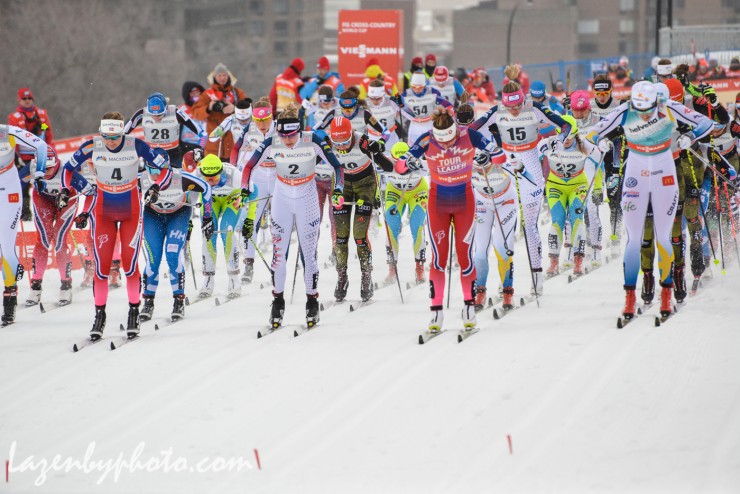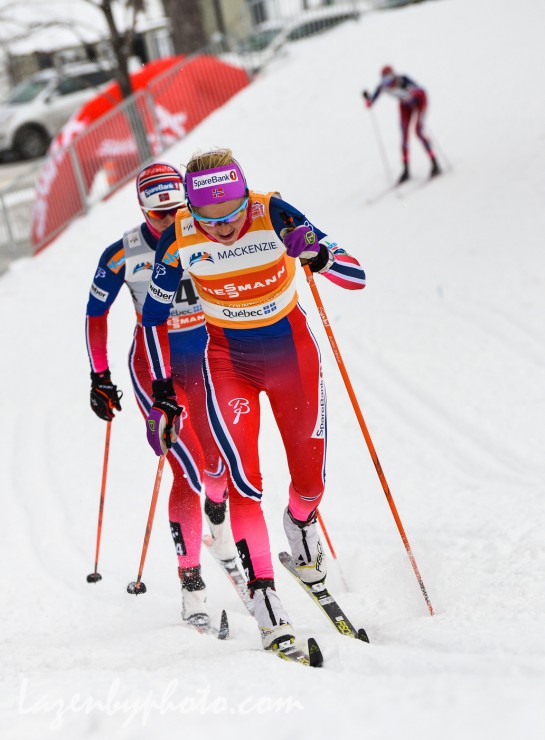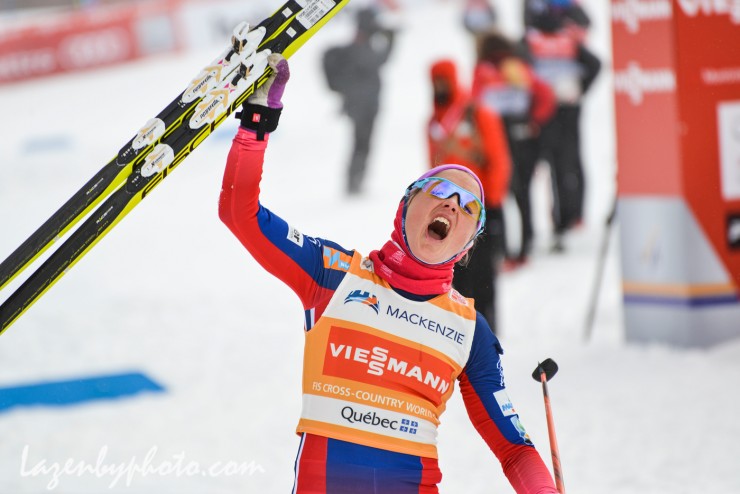
If any World Cup athletes forgot that cross-country skiing is a winter sport, they received a stark reminder on Wednesday in Montreal, Quebec, for the second day of the Ski Tour Canada.
While this season has been characterized by ribbons of manmade snow across a brown landscape and unseasonably warm temperatures, the plunge back to frigid conditions and fresh snow during the classic mass start at Stage 2 of the Tour brought back the balaclavas.

At race time, temperatures hovered around 16 degrees Fahrenheit, but a brutal 20 to 30 mile-per-hour winds made it downright frigid. In addition to the wind, a steady snowfall made for a soft course in the unique race venue at Parc du Mont-Royal. Dating back to 1879, it is the oldest skiing site in Canada located in the midst Quebec’s largest city of Montreal.
The course was windy and narrow with several areas likely to cause bottlenecks in a mass start event with a large (72-woman) field. This factor made start position and staying out of trouble big factors in staying in the hunt.
Racers were issued bib numbers based on their overall Tour standings from Tuesday’s sprint, giving Diggins a front-row start while overall World Cup leader Therese Johaug started four rows back in bib 27 — a spot she is not accustomed to.
Johaug’s start position spared the field the relentless pace she usually pushes from the gun. At the 1 kilometer mark, the field remained bunched on the narrow course with Sweden’s Charlotte Kalla and Norwegians Heidi Weng and Maiken Caspersen Falla leading the charge. Americans Jessie Diggins and Sadie Bjornsen asserted themselves near the front, maintaining position in the top 10.
“I was a little bit nervous before the start today because my start position was not where I was used to,” Johaug said in a post-race press conference. “It was really tough in the beginning there because there was so many girls and it was crazy behind there so I have to focus on myself and take it step by step.”
Within two kilometers, Johaug had found her niche at the front as the field began to string out. But Norwegian teammates Astrid Uhrenholdt Jacobsen and Weng were not going to let her go without a fight as they attempted to match Johaug’s pace. By the 3.5 k checkpoint, Jacobsen and Johaug had established a 20-second gap on the field while Weng dangled eight seconds behind the two.
However, Johaug’s pace was relentless and Jacobsen soon conceded to reconvene with Weng by the 5.5 k mark, 27 seconds behind Johaug. Despite being dropped by Johaug, the pair maintained a 30-second gap on the rest of the field. Meanwhile, a chase group of 15, including Diggins and Bjornsen, fought for the only skied-in tracks as the snow accumulated.

Johaug showed no mercy during the second half of the three-lap race as she continued to extend her lead. She posted a time of 30:05.6 over 10.5 k to win by a full minute over Weng. In the final kilometers, Weng distanced herself from Jacobsen to secure second, 1:00.3 behind Johaug and 9.5 seconds ahead of Jacobsen in third.
“When I [decided to] go, I hoped that me and Astrid can take some seconds to Therese, but Astrid was very tired,” Weng recalled in the press conference. “I thought that, ‘OK I can go and maybe she hang on,’ but I got some seconds.”
Still, after finishing a minute behind Johaug, Weng trails her by 26 seconds in the Tour standings — a big gap to overcome with four of the six remaining stages being distance races.
“I was very good yesterday,” Weng said of the sprint, where she placed fourth. “But when you lose one minute and Therese gets all of the bonus seconds … I must be better in the distance and train more.”
Johaug’s dominant win puts her in the overall lead in the Tour, back in bib 1. She holds a 26.8 second lead over Weng and 1:10.8 over Jacobsen in third heading into Friday’s freestyle sprint in Quebec City.
“I’m really happy that I did not think that I should be in front in just 200 meters, but I used the first kilometer to go up in front,” Johaug said. “My skis today were so good and the shape is also really good at the moment. I can just push the whole way and I know that I must also push all the way because I need all the seconds I can get in front of the Tour.”
Finishing 30 to 40 seconds after Jacobsen, the remainder of the top-10 positions were determined in a congested push to the finish with Falla taking advantage of her sprinting prowess to secure fourth, 1:42 behind Johaug and 32.2 seconds off the podium. Just 0.8 seconds behind Falla, Poland’s Justyna Kowalczyk placed fifth and Norway’s Ingvild Flugstad Østberg finished another 0.2 seconds back in sixth.
Double poling toward the finish near the back of the five-woman chase pack, Diggins essentially ran out of room without any place to move around the racers ahead of her, as the group double poled in side-by-side rows to the finish. She finished eighth (+1:43.5), two-hundredths of a second behind Finland’s Kerttu Niskanen in seventh and just 1.5 seconds behind Falla.

Diggins’ finish put her fifth in the overall Tour after claiming third in the freestyle sprint on Tuesday. She sits just 9.5 seconds behind Falla in fourth and 1:23.7 behind Johaug in the overall standings.
“That was a very different race than we have had in a long time,” said Diggins in an in-person interview after Wednesday’s race. “The wind gusts were incredible. It became pretty tactical because really only one of the tracks was skied in so if you found yourself outside of it you were working twice as hard. So that in itself was a bit part of the race.”
Eighth place stood as her second-best classic result in a World Cup since finishing fifth in last month’s 5 k classic in Falun, Sweden.
“I was really pleased with it,” Diggins said of Wednesday’s race. “A couple years ago I never could have done that on a day like today with super-tricky kick. It took finesse on those gradual uphills to try make your skis work. It was hard out there for everyone but I think I had great skis.”
Despite holding position in the top 10 for the first two of three laps, Bjornsen lost contact with the larger chase group to finish 16th (+2:04.2).
“The first couple of laps were good, and then I started sort of stressing and slipping a lot and fell back a ways,” Bjornsen said afterward. “But I was definitely happy with how it felt the first couple laps.”
Americans Liz Stephen and Rosie Brennan also scored World Cup points in the top 30, placing 22nd (+2:44.3) and 28th (+3:05.8), respectively.
“It was good, a decent place to be, I think, at this point of the Tour,” Brennan said after tying her season best (she placed 28th in a World Cup 10 k freestyle in January in Nove Mesto, Czech Republic). “The Tour is long; it’s about every day, not one day, but I am always psyched to be in the points.”

For racers starting farther back in the field, the mass start on the narrow course posed a significant challenge to navigate.
“Because we knew there were going to be some bottlenecks, we talked to all the women about trying to get a pretty fast start and move up a few places to get in front of some of the bottlenecks,” U.S. Ski Team Head Coach Chris Grover explained in a post-race phone interview.
In theory, it was a great strategy, but certainly easier said than done. One of the woman most successful at pulling this off was Stephen, who started in bib 59 and successfully navigated the chaos of the mass start to move into the top 25 in the first half of the race. Over the last few kilometer, she picked off a few more places to finish 22nd.
“I was lucky to avoid all the crashes that happened in the first lap,” Stephen said in a phone interview. “The start was crazy and the course was really fun once it was more spread out, but it was a really tough course to have a mass start on because of the steep ups and downs and narrow track with the snowy conditions. I am happy with my race today as I was feeling strong the whole time and was able to push my head and my body.”
Also competing for the U.S. was Chelsea Holmes (APU) 38th, Kaitlynn Miller (CGRP) 39th, Ida Sargent (CGRP/USST) 40th, Sophie Caldwell (SMST2/USST) 42nd, Caitlin Gregg (Team Gregg/USST) 47th, Jennie Bender (BSF) 51st, Katherine Ogden (SMS/USST) 59th, and Annie Hart (SMST2) 61st.
While many of the U.S. women were able to stay out of trouble, there were a number of crashes on the congested course. Both Sargent and Hart fell victim to race-altering crashes.
Sargent broke a ski after crashing into Sweden’s Hanna Falk, who fell in front of her. But she was able to finish the race after quickly receiving a new ski from a coach and went on to finish 40th.
“Ida was really bummed because she saw this as an opportunity to have a really good classic distance race,” Grover said. “It is ironic because Falk is who crashed in front of her yesterday in the sprint. She did a great job of clawing back place by place.”
Hart’s race was also thwarted when she became tangled in a pileup at the start.
“It was pretty crazy, about 500 meters in there was a gigantic pileup that I had the liberty of being on the bottom of,” Hart said in an in-person interview. “I’ve never quite been underneath ten girls. That felt a little bit frustrating, but after that I just tried not to panic and just tried to pick people off. So, it was an experience.“
Emily Nishikawa of the Canadian Senior Development Team was also involved in the same crash, but recovered to lead the Canadian women in 45th place (+4:39.7).
“I fell off the trail, I had my skis tangled up in the fence and I hit the fence pretty hard,” Nishikawa said afterward. “I was the very last person leaving that corner so I had to make up a lot of ground, but I think after that I skied well.”
Canadian coach Justin Wadsworth commended Nishikawa’s recovery following the incident.
“She probably lost about 45 seconds or a minute just trying to get onto the trail again,” he said. “I was trying to even help her and it was a real mess. I think she skied a very good race, especially regaining her composure.”
She was followed by Canadians Cendrine Browne (CNEPH/CNST) 48th, Katherine Stewart-Jones (NDC Thunder Bay) 52nd, Olivia Bouffard-Nesbitt (CNST) 53rd, Andrea Dupont (RMR) 57th, Annika Hicks (Canmore Nordic) 60th, Jennifer Jackson (NDC Thunder Bay) 63rd, Alannah MacLean (NDC Thunder Bay) 64th, Dahria Beatty (AWCA/CNST) 65th, Maya Macisaac-Jones (RMR) 67th, Sophie Carrier-Laforte (CNEPH) 68th, and Marie Corriveau (CNEPH/National Junior Team) 72nd.
With a large, young contingent of Canadians racing, the Tour is the unique opportunity to race on the highest level in their home country.
“I think today was an experience for the best racers in the world, who have been racing many years on the World Cup,” Wadsworth said.”So for the younger athletes, it was a real eye opener. It was very hard conditions, with the wind and the snow and the course. Most of them seem to have pretty good attitudes about it, so hopefully they get some good learning out of it.”
Results | Tour standings (through Stage 2)
— Gerry Furseth, François Léger Dionne, Jason Albert, Harald Zimmer, and Alex Kochon contributed

Kaitlyn Patterson
New to the FasterSkier team, Kaitlyn is a silent sports all-arounder, competing in cross-country skiing, cycling and triathlon since graduating from the University of Michigan, where she ran cross country and track. Kaitlyn is intrigued by the complexities of cross-country ski racing and is excited to start in the elite women’s field at the 2016 Birkie.



